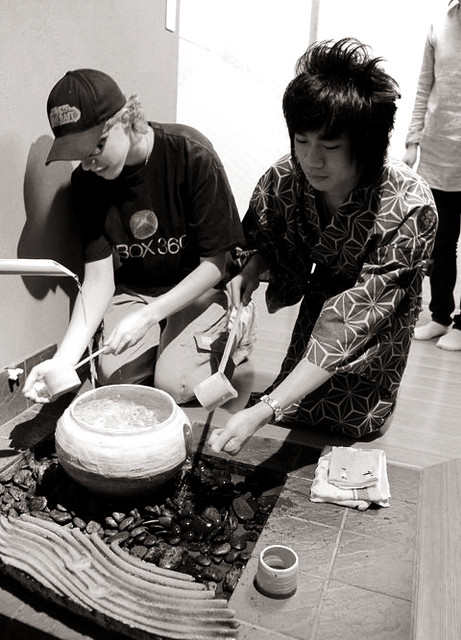
KCP Students Experience Sadou and the Purikura
KCP student Steven Z. Edwards and his classmates continue their adventures in Japan by visiting a purikura. He also gives us an inside peek at sadou (also called “chanoyu” or “chadou”), the centuries-old Japanese tradition of the tea ceremony.
Sadou
Tea was introduced in 9th century Japan by Eichu, a Buddhist monk. The country has never slowed its love affair with tea. Sadou is a tea ceremony, a “transformative practice” that has developed into wabi-sabi, the quiet refinement in simplicity, humility, imperfection, and the effects of time and care in objects.
Student and Teacher Tea Ceremony hosted by the Thai classmates Pla and Erng in the front.| KCP at Flickr
Ending the wonderfully-done Tea Ceremony! | KCP at Flickr
Sen no Rikyu greatly developed the tea ceremony. With his beliefs in Ichi-go-Ichi-E that means “for this time only”, “never again,” or “one chance in a lifetime”, his approach also influenced Japanese architecture, horticulture, and the arts. His principles of tranquility, harmony, respect, and purity are still widely observed in today’s Japanese tea ceremonies.
Steven and Kanaphone, our best friend that was only in our class for a day before shooting up 2 levels. |KCP at Flickr
The 1880s brought about the collection of different tea equipment such as tea cups and kettles, still highly prized today. Many are shown in private museums such as Goto Art Museum, Fujita Art Museum, and Itsuo Art Museum.
Find out more about the Japanese tea ceremony by reading our related blog post!
Purikura
After challenging but fun days in the classroom, Steven and other KCP classmates take a break by having their photos taken in a purikura.
Purikura (プリクラ) is a coin-operated photo booth. It usually has a seat facing a camera and is surrounded by a curtain. After dropping a few coins into the slot, you can then pose for pictures. Depending on the type of booth, a series of photos aretaken with a light or a buzzer to indicate when the next shot will occur. Modern booths take only one shot and print out several identical copies that take about 30 seconds to print. The same process happens in booths that produce photo sticker images with variousfancy designs that were all the rage in the 90s. The numerous photo sticker booths are still very popular in Japan.
A couple of KCP American friends and a mutual Japanese friend got Purikura’d! Kaito, Steven, Haley, and Allison. | KCP at Flickr




